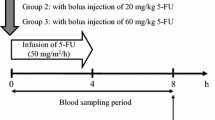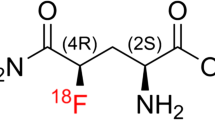Summary
The influence of infusion time and dose on the anticancer efficacy of 5-fluoro-2′-deoxyuridine (FdUrd) was investigated using a locoregional therapy model: Novikoff hepatoma transplanted i.m. into the thigh of Wistar rats and FdUrd infusion via a catheter implanted in the femoral artery. In experiment A the FdUrd dose (five daily doses of 12, 19 and 30 mg/kg) and the duration of administration (bolus, 1 h, 5 h, and 24 h) were varied. The change in tumor volume following treatment and the number of rats showing regression vs progression served as indicators of therapy response. The results showed a clear dose dependence, and for each infusion time the 30 mg/kg dose was the most effective, without any signs of general toxicity. At this dose the longest infusion time (24 h) was less effective (regression in three of six rats) compared with 1-h or 5-h treatments (four of five in regression). In experiment B either one or five daily FdUrd doses (15, 30, 60 mg/kg) were administered i.a. for the same infusion times used in experiment A. After treatment, tumors were explanted ex vivo and approximately 1-g tissues samples were immediately frozen in liquid nitrogen for storage.19F-NMR spectroscopy at 11.7 T was used to quantify FdUrd metabolites [5-fluorouracil (FUra),α-fluoro-β-alanine (FβAla.), 5-fluorouracil nucleosides and nucleotides (F-Nuc)] in the solid tumor tissue samples (maintained at 4° C) with a detection threshold of about 5 nmol/g. The metabolite signal pattern indicated that FdUrd is first converted to FUra, followed by anabolism primarily to nucleotides in the oxy form (e.g. FUTP). The total amount of fluorine detected in tumor tissue increased with dose and decreased with infusion time. For all treatments FNuc could be detected, even after 24 h infusion, and their levels showed a good linear correlation with the total F. The major catabolite FβAla was present in tumor at low levels that correlated poorly with total F, indicating recirculation from other organs (e.g. liver) as the main source. Thus, the NMR method can provide detailed information regarding the efficiency of locoregional treatment (catheter function, drug uptake and metabolism). Initial results of non-invasive in vivo NMR experiments are also presented.
Similar content being viewed by others
Abbreviations
- FUra:
-
5-fluorouracil
- FNuc:
-
all 5-fluorouracil nucleosides e.g. FUrd, FdUrd
- FNucP n :
-
all 5-fluorouracil nucleotides e.g. FUMP, FdUMP, FUTP
- FβAla:
-
α-fluoro-β-alanine
- total F:
-
sum of all fluorine-containing metabolites
- T 1 :
-
nuclear spin lattice relaxation time
- FNuc(P n):
-
all FUra anabolites
References
Aguiar JLA, Berger MR, Frank N (1987a) Locoregional application of 5-fluorouracil to the liver: alteration of pharmacokinetics and bone marrow toxicity in rats with thioacetamide-induced cirrhosis. Toxicol Lett 36:181–188
Aguiar JLA, Bartkowski R, Berger MR, Petru E, Schlag P, Schmähl D (1987b) Feasible model for locoregional and systemic longterm administration of drugs and concomitant blood sampling in Sprague-Dawley rats. J Cancer Res Clin Oncol 113:27–30
Bartkowski R, Berger MR, Aguiar JLA, Henne TH, Dörsam J, Geelhaar GH, Schlag P, Herfarth C (1986) Experiments on the efficacy and toxicity of locoregional chemotherapy of liver tumors with 5-fluoro-2′-deoxyuridine (FUDR) and 5-fluorouracil (5-FU) in an animal model. J Cancer Res Clin Oncol 111:42–46
Berger MR, Henne TH, Aguiar JLA, Bartkowski R, Dörsam J, Geelhaar GH, Schlag P, Herfarth C, Schmähl D (1986) Experiment on the toxicity of locoregional liver chemotherapy with 5- fluoro-2′-deoxyuridine and 5-fluorouracil in an animal model. Recent Results Cancer Res 100:147–156
Bernadou J, Armand JP, Lopez A, Malet-Martino MC, Martino R (1985) Complete urinary excretion profile of 5-fluorouracil during a six-day chemotherapy schedule, as resolved by19F nuclear magnetic resonance. Clin Chem 31:846–848
Cabanac S, Malet-Martino MC, Bon M, Martino R, Nedelec JF, Dimicoli JL (1988) Direct19F NMR spectroscopic observation of 5-fluorouracil metabolism in the isolated perfused mouse liver model. NMR Biomed 1:113–120
Chabner BA (1982) Pyrimidine antagonists. In: Chabner B (ed) Pharmacological principles of cancer treatment. Saunders, Philadelphia, pp 183–212
Friedel P, Berger MR, Rozycki-Gerlach W, Schlag P, Schmähl D (1987) Studies on experimental liver infusion and additional systemic detoxification. Cancer Treat Rev 14:247–255
Grün BR, Berger U, Oberdorfer F, Hull WE, Ostertag H, Friedrich E, Lehmann J, Keppler D (1990) Metabolism and actions of 2-deoxy-2-fluoro-D-galactose in vivo. Eur J Biochem 190:11–19
Heidelberger C, Danenberg PV, Moran RG (1983) Fluorinated pyrimidines and their nucleosides. Adv Enzymol 54:57–119
Hohenberger P, Hull WE, Schlag P (1990) Detection of cytotoxic anabolism of 5-FU in patients with colorectal liver metastases using F-19 NMR spectroscopy following intra-operative chemotherapy. In: Häring R, et al. (ed) Chirurgisches Forum 1990 für experimentelle und klinische Forschung. Springer, Berlin Heidelberg New York, pp 283–287
Hull WE, Port R, Kunz W, Schlag P (1987)19F-NMR for monitoring 5-fluorouracil chemotherapy. J Cancer Res Clin Oncol 113:S46
Hull WE, Port R, Kunz W, Schlag P (1988a)19F-NMR for monitoring 5-fluorouracil chemotherapy. (abstract) Soc Magnet Reson Med 6:107
Hull WE, Port RE, Herrmann R, Britsch B, Kunz W (1988b) Metabolites of 5-fluorouracil in plasma and urine, as monitored by19F nuclear magnetic resonance spectroscopy, for patients receiving chemotherapy with or without methotrexate pretreatment. Cancer Res 48:1680–1688
Kemeny N, Daly J (1986) Preliminary results of a randomized study of intrahepatic infusion versus systemic infusion of 5-fluoro-2′-deoxyuridine for metastatic colorectal carcinoma. Recent Results Cancer Res 100:171–178
Malet-Martino MC, Armand JP, Lopez A, Bernadou J, Béteile JP, Bon M, Martino R (1986) Evidence for the importance of 5′-deoxy-5-fluorouridine catabolism in humans from19F nuclear magnetic resonance spectrometry. Cancer Res 46:2105–2112
Martino R, Lopez A, Malet-Martino MC, Bernadou J, Armand JP (1985) Release of fluoride ion from 5′-deoxy-5-fluorouridine, an antineoplastic fluoropyrimidine, in humans. Drug Metab Dispos 13:116–118
McSheehy PMJ, Griffiths JR (1989)19F MRS studies of fluoropyrimidine chemotherapy. A review. NMR Biomed 2:133–141
McSheehy PMJ, Prior MJW, Griffiths JR (1989) Prediction of 5-fiuorouracil cytotoxicity towards the Walker carcinoma using peak integrals of fluoronucleotides measured by MRS in vivo. Br J Cancer 60:303–309
Naser-Hijazi B, Berger MR, Schmähl D, Hull WE, Schlag P (1989) Influence of different locoregional administration on 5-fluoro-2′-deoxyuridine (FUDR) metabolism in Novikoff hepatomabearing Wistar rats. J Cancer Res Clin Oncol 115:S36
Naser-Hijazi B, Berger MR, Schmähl D, Hull WE (1990) Quantification of 5-FU metabolites in rat tissues after locoregional administration using19F-NMR spectroscopy. J Cancer Res Clin Oncol [Suppl] 116:558
Pinedo HM, Peters GFJ (1988) Fluorouracil: biochemistry and pharmacology. J Clin Oncol 6:1653–1664
Prior MJ, Maxwell RJ, Griffiths JF (1990) In vivo19F-NMR spectroscopy of the antimetabolite 5-fluorouracil and its analogues. Biochem Pharmacol 39:857–863
Semmler W, Bachert-Baumann P, Gückel F, Ermark F, Schlag P, Lorenz WJ, van Kaick G (1990) Realtime follow-up of 5-fluorouracil metabolism in the liver of tumor patients by means of F-19 NMR spectroscopy. Radiology 174:141–145
Wolf W, Albright MJ, Silver MS, Weber H, Reichardt U, Sauer R (1987) Fluorine-19 NMR spectroscopic studies of the metabolism of 5-fluorouracil in the liver of patients undergoing chemotherapy. Magnet Reson Imaging 5:165–169
Wolf W, Presant CA, Servis KL, El-Tahtawy A, Albright MJ, Barker PB, Ring III R, Atkinson D, Ong R, King M, Singh M, Ray M, Wiseman C, Blayney D, Shani J (1990) Tumor trapping of 5-fluorouracil: in vivo19F-NMR spectroscopic pharmacokinetics in tumor-bearing humans and rabbits. Proc Natl Acad Sci USA 87:492–496
Author information
Authors and Affiliations
Additional information
This work was supported in part by a grant from the Tumorzentrum Heidelberg/Mannheim
Rights and permissions
About this article
Cite this article
Naser-Hijazi, B., Berger, M.R., Schmähl, D. et al. Locoregional administration of 5-fluoro-2′-deoxyuridine (FdUrd) in Novikoff hepatoma in the rat: effects of dose and infusion time on tumor growth and on FdUrd metabolite levels in tumor tissue as determined by19F-NMR spectroscopy. J Cancer Res Clin Oncol 117, 295–304 (1991). https://doi.org/10.1007/BF01630711
Received:
Accepted:
Issue Date:
DOI: https://doi.org/10.1007/BF01630711




